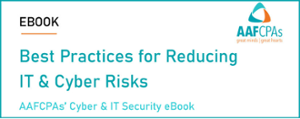Keys to a Successful Accounting Software Implementation
Implementing a new accounting software application requires significant investments in time, energy, and financial resources. A proper implementation plan is key to maximizing the long-term value of your new system.
AAFCPAs Provides the Following Best Practice Recommendations to Ensure Clients Get the Most Out of Their New System:
Change is Hard
AAFCPAs advises clients to acknowledge the need for a cultural shift and to gain buy in with everyone in the organization.
- Set the tone at top
- Identify a few key champions
- Ensure everyone understands the benefits to them individually and to the organization, as well as the detriment if no change is made
Project Management
AAFCPAs advises clients to set and manage to a realistic time frame.
- Create a project plan with milestones, deadlines, and task assignments
- Prepare a functional requirement document based on the system requirements specifications (SRS) developed during the system selection process
- Consider a “phased in” approach
- Define “go/no go” criteria for your go-live date
- Monitor and control scope creep
Create a Strong Foundation
Getting your Chart of Accounts (COA) and financial dimensions correct is 90% of implementation success and can drive real business benefits through performance insights. A new general ledger system provides organizations with an opportunity to improve processes, data integrity, and information consistency.
- Interview information stakeholders to understand how the COA drives performance insights. Who needs what information, how, and when?
- Consider all reporting requirements when designing the COA
- Eliminate manual work and get out of Excel spreadsheets by utilizing the new system whenever possible
Historical Data
If you invested time in creating a new, stronger foundation and COA, your historical data may not easily fit into your new multi-dimensional configuration. And, the process for scrubbing and recreating the history in the new system can significantly affect your timeline and costs.
- AAFCPAs advises clients to evaluate your data conversion choices and to review your options with your implementation partner and your IT team
- Determine how much data to bring over. Determine if you are going to use the historical data on a regular basis. If not, can you store historical data in the old system or in another data source and access it as required?
- Clean up vendor and customer lists
- Create a “mapping” from your current COA to new COA and dimensions
- Consider adding “historical” dimensions for any projects, departments, locations, or grants that are no longer relevant
Training, Testing, and Documentation
AAFCPAs advises clients to plan for adequate training, testing, and documentation.
- Hands on user training is most effective
- User Acceptance Testing is key and should not be rushed
- Document new processes as you go
Security
AAFCPAs advises clients to thoroughly understand the security setup of user accounts in the new system.
- Familiarize yourself with IT & Cyber risks and develop a plan to mitigate the risks
- Map out roles, permissions, and user assignments within the application
- Take a “least permissive” approach, and grant only as much access as is necessary for a user to perform his/her duties
- Consider security as part of your testing plan; that is, do not give access to everyone/everything for “testing” purposes
- Review roles, permissions, and user assignments to roles at least quarterly
Go Live Plan
- Review the “go/no go” criteria and ensure the team is comfortable with training and testing
- Identify at least one Power User who “owns” the system going forward
- Make certain your implementation partner is available for assistance during your first check run and first bank reconciliation process
- Do not forget to bring over amounts paid to date during the current year for 1099 vendors
- Confirm that all key financial reports are built out and tested
Periodic Review
- Plan for system review with key stakeholders at 30, 60, and 90 days after implementation
- Review new features and functionality at least quarterly
- Review business processes and add automation as new requirements become known
- Stick to the plan–don’t stop after the first phase
- Sign up for user groups and annual conferences hosted by the software provider
Many clients utilize Intacct as their accounting/financial application system. Read AAFCPAs’ blog on Implementation Tips Specific to Sage Intacct. >>
Implementation is a shared process between finance, IT leaders, implementation teams, system champions, and the rest of the organization. Implementation teams are encouraged to maintain engagement and communications throughout the implementation process.
AAFCPAs provides strategic guidance on the selection and deployment of key business applications and technologies to meet corporate objectives and drive productivity. If your organization is considering implementing a new system, or has already started on the implementation journey, and would like to discuss your approach, please contact your AAFCPAs Partner.

